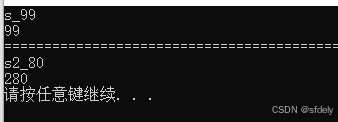C#-Dictionary-字典学习
此段之后为正文,前面为格式设置color=#00f555f size=5 face=“黑体”
1.引入库
代码如下(示例):
<span style="color: #00ff7f;">// 修改注释颜色</span>
<font color=#0099ff size=5 face="黑体">color=#0099ff size=5 face="黑体"</font>
using System;
using System.Collections.Generic;
using System.Linq;
using System.Text;
using System.Threading.Tasks;
namespace 键值对Dictionary
{
internal class Program
{
static void Main(string[] args)
{
Dictionary<string, Student> stuDic = new Dictionary<string, Student>(); //创建了唯一的字典
Student stu = new Student(); //创建了唯一的Student对象
for (int i = 0; i < 100; i++)
{
stu.Name = "s_" + i.ToString();
stu.Score = i;
stuDic.Add(stu.Name, stu); //每次循环创建一个 键值对,故一共创建了100个键值对
}
Console.WriteLine(stuDic["s_80"].Name);
Console.WriteLine(stuDic["s_80"].Score); //指向了唯一的Student对象,输出99
Console.WriteLine("============================================================");
Dictionary<string, Student> stuDic_2 = new Dictionary<string, Student>(); //创建了唯一的字典
string varName = "";
for (int i = 0; i < 100; i++) //i只在for循环中创建,循环完后自动注销
{
Student stu2 = new Student(); //创建了100个Student对象
stu2.Name = "s2_" + i.ToString(); //对
stu2.Score = 200 + i;
varName = "varName"+i.ToString();
stuDic_2.Add(varName, stu2);
}
Console.WriteLine(stuDic_2["varName80"].Name);
Console.WriteLine(stuDic_2["varName80"].Score);
}
}
}
class Student
{
public string Name;
public int Score;
}
输出结果:

结论
特点:
只创建了一个 Student 对象:
在循环开始时,创建了一个 Student 对象 stu。
每次循环中,stu 的 Name 和 Score 属性被覆盖,但 stu 仍然是同一个对象。
字典中的所有值指向同一个对象:
由于 stu 是同一个对象,"stuDic 中的所有键值对的值实际上都是对 stu 的引用"。
最终,"字典中的所有 Student 对象都具有相同的属性值(即最后一次迭代时的 Name 和 Score)"。
总结:
这种写法会"导致字典中所有值都指向同一个 Student 实例",最后字典中的每个条目的 Name 和 Score 都是 "s_99" 和 99。
示例输出: 如果执行 Console.WriteLine(stuDic["s_80"].Score);,结果为 99,而不是 80。
这种写法通常是错误的,除非开发者明确需要所有键值对引用同一个对象。
"字典不允许重复键":
如果尝试插入一个已经存在的键(例如 stuDic.Add("s_1", stu),当 "s_1" 已经存在时),字典会抛出 ArgumentException。
这段代码中不会发生这种情况,因为 stu.Name 始终是动态生成的,值由循环控制,确保了唯一性。























 361
361

 被折叠的 条评论
为什么被折叠?
被折叠的 条评论
为什么被折叠?








